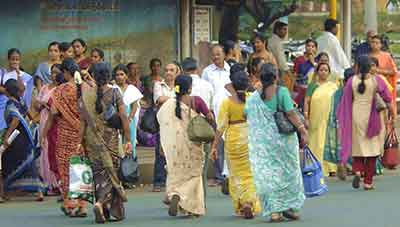Date: 13/02/2023
Relevance: GS-1: Women Empowerment and related Issues.
Relevance: GS-2: Education and Skill Development.
Key Phrases: Economic Survey, Digital Literacy, Literacy Gap, Gender Disparity, Periodic Labour Force Survey, NSO, Women Empowerment, Workforce, Unemployment Rate, Strategy for New India @75, Expenditure-saving work, SDG 8.
Context:
- Recently released Economic Survey (2022-23) acknowledged that
official statistics may have inadequately captured the true nature of
women’s work in India.
- This inadequacy affects both how we perceive women’s economic contributions and the policies we develop to enhance women’s economic participation.
Key Highlights:
- Women's engagement in salaried work provides an impetus for households to switch away from such domestic drudgery and invest in time-saving infrastructure such as LPG cylinders.
Findings of Economic Survey 2022-23:
- Sources of Measurement Error:
- Using very broad categories that club productive economic activity with domestic unpaid work (such as in activity code 93 in NSS, or National Sample Survey, employment surveys);
- Asking single-shot questions without probing to categorize women’s work;
- Not capturing expenditure-saving work that contributes to household wellbeing.
- Other Constraints in Measurement:
- Interviewers as well as respondents tend to overlook women’s work, particularly work in family-based enterprises.
- While male farmers think of themselves as employed in farming, women farmers see farm activities as simply extensions of their household duties.
Recommendations of Economic Survey:
- The Economic Survey recommends improving measurement of women’s work.
- Its proposal to expand the definition of what counts as employment is ingenious.
- The 2019 Time Use Survey shows that women often engage in a
variety of activities that can be classified as “expenditure-saving”.
- This includes the collection of firewood, fetching water, preparing atta from wheat to reduce purchasing costs, tutoring children and cooking.
- The Economic Survey suggests that we should recognise this “work” along with “employment” and collect this information through redesigned surveys.
- The Economic Survey further recommends revising labour force surveys
to bring them in line with methodologies recommended by the International
Labour Organization (ILO), listing a predefined set of activities, to
eliminate underreporting.
- However, this approach has two shortcomings-
- One, it conflates activities within and outside of the System of National Accounts (SNA) production boundary where own-use production of goods such as growing vegetables or caring for livestock is seen as being within the production boundary while tutoring children is generally considered outside the production boundary.
- Two, activities that are undertaken due to a shortage of infrastructure are suddenly seen as being valuable rather than classified as “domestic drudgery”.
- However, this approach has two shortcomings-
Periodic Labour Force Survey
- About:
- National Statistical Office (NSO) launched the Periodic Labour Force Survey (PLFS) in April 2017.
- Objective:
- To estimate the key employment and unemployment indicators (viz. Worker Population Ratio, Labour Force Participation Rate, Unemployment Rate) in the short time interval of three months for the urban areas only in the ‘Current Weekly Status’ (CWS).
- To estimate employment and unemployment indicators in both ‘Usual Status’ (ps+ss) and CWS in both rural and urban areas annually.
- Terminology:
- Labour Force Participation Rate:
- LFPR is defined as the percentage of persons in labour force (i.e. working or seeking or available for work) in the population.
- Unemployment Rate:
- UR is defined as the percentage of persons unemployed among the persons in the labour force.
- Worker Population Ratio (WPR):
- WPR is defined as the percentage of employed persons in the population.
- Activity Status- Usual Status:
- The activity status of a person is determined on the basis of the activities pursued by the person during the specified reference period.
- When the activity status is determined on the basis of the reference period of the last 365 days preceding the date of survey, it is known as the usual activity status of the person.
- Activity Status- Current Weekly Status (CWS):
- The activity status determined on the basis of a reference period of last 7 days preceding the date of survey is known as the current weekly status (CWS) of the person.
- Principal activity status:
- The activity status on which a person spent relatively long time (major time criterion) during 365 days preceding the date of survey, was considered the usual principal activity status of the person.
- Subsidiary economic activity status:
- The activity status in which a person in addition to his/her usual principal status, performs some economic activity for 30 days or more for the reference period of 365 days preceding the date of survey, was considered the subsidiary economic status of the person.
- Labour Force Participation Rate:
- Key Highlights of Annual PLFS 2020-21:
- Overall unemployment rate as per usual status (reference period of last 365 days preceding the survey), eased to 4.2% from 4.8% in 2019-20.
- The labour force participation rate (LFPR) was the highest in four years at 39.3 per cent in 2020-21.
- Employment in the unpaid self-employed category continued to show an increase in 2020-21 by rising to 17.3% from 15.9% in 2019-20.
Way Forward:
- Politically this is quite appealing, and consistent with one stream of feminist activism.
- Expanding the definition of work immediately expands the number of women workers — including almost the total adult female population in India — and softens the stigma of low female work participation rates in India. It also dovetails with the feminist advocacy that has sought recognition of women’s unpaid work.
- By valorising women’s diverse activities, we may treat their vulnerabilities as strengths and fail to acknowledge the lack of access to income-generating activities for women.
Conclusion:
- As India aspires to achieve inclusive economic growth and provide avenues of decent work conditions for all workers in line with Sustainable Development Goal 8, getting measurement of women’s economic activities right is of utmost importance.
Source: The Hindu
Mains Question:
Q. Suggest measures to improve the methodology for counting the women’s true work participation. (150 Words).






















